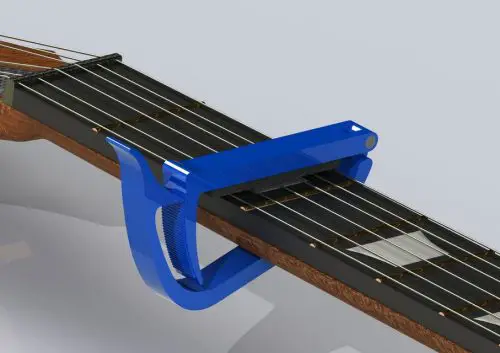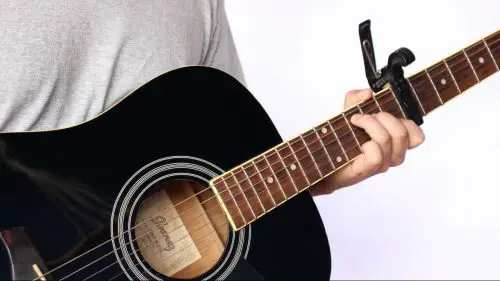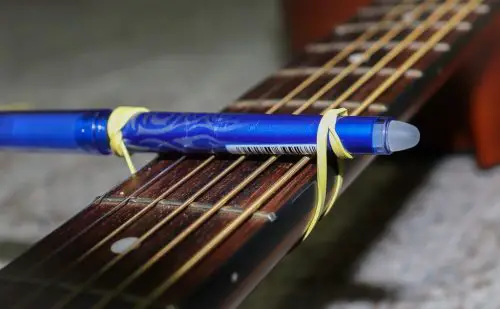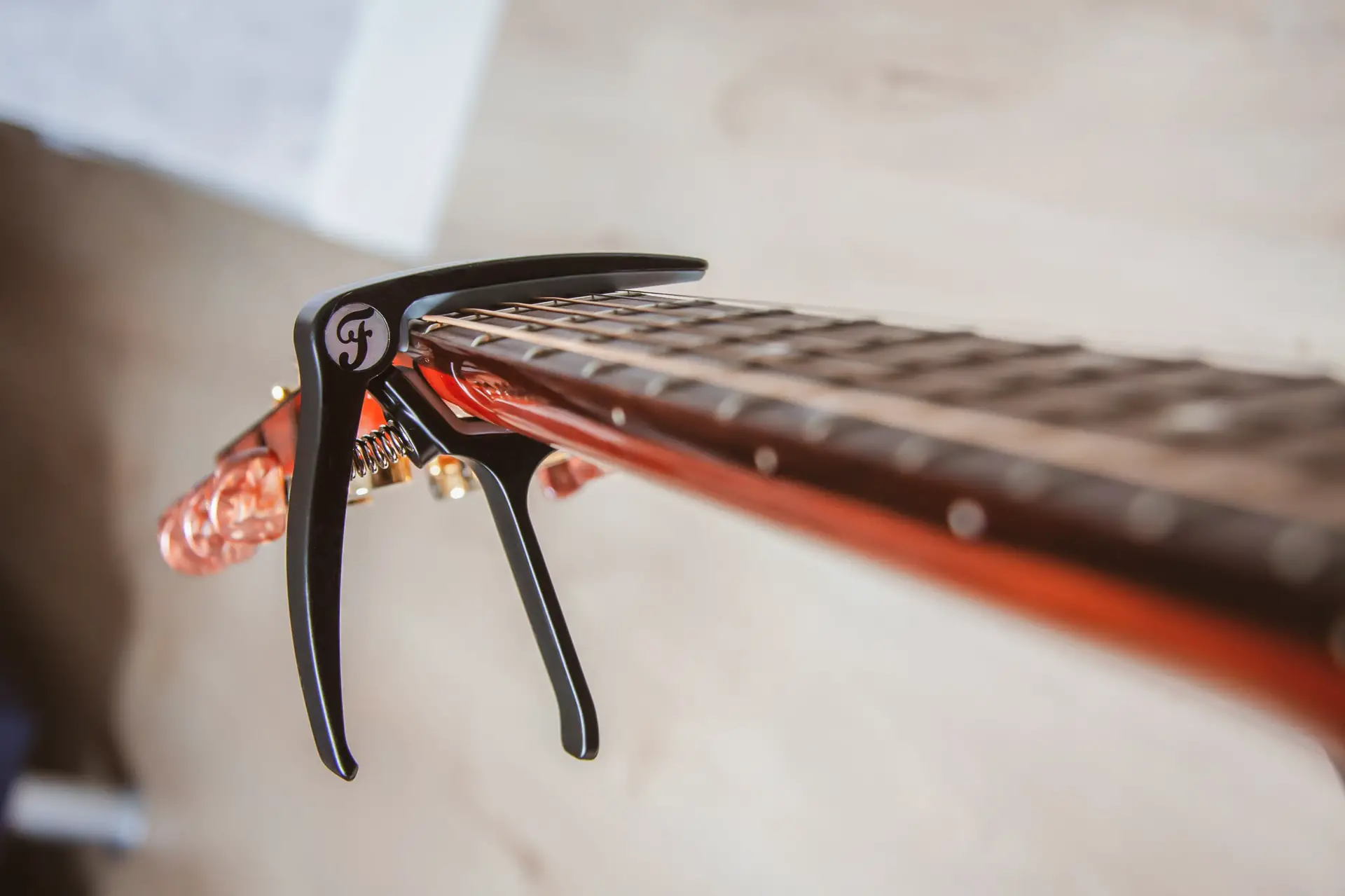A capo is great to make guitar playing easy – complex chords become easier to play and suddenly you can play more songs than you normally could.
That said, a capo also has its cons like restricting the available space in the fretboard – restricting you when playing moves like bends.
Personally, out of all the pros and cons, I still think capo is a great tool to have around – regardless of whether you are a beginner or professional guitarists. I haven’t met any guitarists who don’t own a capo.
I’ve been through the phase where I used the capo blindly without understanding how it works. And trust me, the way I looked at the guitar wholly changed when I understood what a capo does.
This article will explain the following topics for you
- Pros & Cons of Using a Capo
- Should Beginners Use a Capo, and Is It Good for Them?
- Is Capo Considered Cheating and Does It Hinder Guitar Learning?
- Do Professionals Use a Capo as Well?
- How to Play Songs Without a Capo?
- Does Using a Capo Change the Key? And What Does It Exactly Mean?
- Should You Use a Capo?
Pros and Cons of Using a Capo
A capo is a great tool, and you can use it to help you progress with guitar, or it can keep you stuck in the same place if you use it blindly.
Here’s a list of a few pros and cons of using a capo.
6 Pros of using Capo
- Capo changes the key. A capo can help you play the same chord shapes in different keys. This allows you to match your voice with the guitar or experiment with different sounds.
- Capo changes the sound of your guitar. The sound of your guitar changes by using a capo. It can become brighter and less deep as you go down the frets. It’s an excellent method to make your guitar do more with minor changes.
- Capo lowers the action of your guitar. The action of your strings is lowered by using a capo. A low action can help you train your barre chords and play for longer.
- Capo makes playing barre chords easier. A capo is barring the entire fret so you don’t have to do it. When you use a capo, you can play a combination of open and barre chords, while giving your hands some rest.
- Capo allows you to play longer. Using a capo is a great way to let your hand rest during your jamming session. For example, if the barre chords start hurting, you can simply use a capo and let it do the rest.
- Capo is easy to use and experiment. A capo is a simple guitar tool that lets you experiment with different tunes with the same shapes. You can create and record other tunes even with knowing just a few chord shapes.

A capo can make your guitar sounds brighter.
5 Cons of using capo
- Many capos might not react well to vibratos and harmonics. It might be difficult to get the same sound if you play a lot of vibratos or harmonics. A capo can slightly restrict your guitar strings from vibrating freely.
- Playing bends can be an obstacle while using a capo. Bends and soloing can be difficult because a capo doesn’t hold your strings as the nut does. The strings won’t bend up or down the same way they would without a capo.
- Capo makes solo-ing tricky. Soloing demands you to hit the right notes and bend them most of the time. A capo restricts you from reaching the lower notes and bending the notes, making soloing tricky. That’s why most guitarists don’t use a capo for soloing.
- Guitar sounds richer without capo. Your guitar can create sounds without a capo that won’t be possible with a capo. For example, palm muting on your open low e string and having low bass notes are difficult to imitate with a capo.
- Capo makes you lose range on the guitar. A capo will restrict you from playing all the notes on your guitar. Moreover, you may not be able to play the highest notes on your guitar.

A capo may limit your hand movement – preventing you from doing big bends and slides.
Is Using a Capo Good for Beginners?
Using a capo is an excellent tool for beginners. Capos can help you play in more keys and make certain chords easier. Beginners stay motivated and inspired to learn further once they can play more songs from fewer chords.
Using a capo can be beneficial for beginner guitar players in multiple ways. Playing guitar becomes fun once you understand how to properly use a capo to your benefit.
As a beginner guitarist, a capo can expand your horizon for guitar playing. Here are a few benefits of using a capo specifically for beginners.
1. Multiple Keys With the Same Chord Shapes
Using a capo works like magic, especially if you’re a vocalist and know only a few guitar chords. Using a capo will help you hit numerous notes with the same chord shapes giving the impression that you’re a guitar god.
You can hit lower notes as you move down the fretboard and higher on the octave. In addition, changing capo positions can let you sing in different octaves with the same chords.
2. Easier Music Composition
As a musician, creating and recording music is one of the most creative and exciting things. And you don’t have to wait to be a professional musician to compose your music.
Even as a beginner guitarist, you should experiment and create your songs. Using a capo is an excellent way to simultaneously experiment and understand different chords.
3. Chords Are Easier to Play
My worst nightmare when I started with the guitar was the barre chords.
Fortunately, capos can assist you with barre chords and a few other chords. In addition, using a capo at the start will keep you motivated to learn further and play more songs.
Putting capo on the first fret and playing an E major shape will give you the sound of an F major chord. Similarly, you can play the B major chord by putting your capo on the second fret and playing the A major shape.
4. Gives Some Rest for Your Fretting Hand
Using a capo also helps you play for longer. As a beginner, the muscles of your hand can’t play barre chords for a long duration.
When you use a capo, you give your fretting hand some rest. The capo takes the pressure off your hand, and you can give your thumb some rest. This rest allows your hand to breathe and lets you play for longer.
5. Lowers The Action
Another benefit that you get from modern capos is that they lower the action of your guitar strings. So if your guitar has high action, using a capo will allow your strings to be lower, and you can finally hit the notes that you were unable to.
Also, if you’re wondering how low-action differs from high-action strings, you can find a detailed guide here.
Should Beginners Use a Capo?
Capos are an excellent tool for beginners, and using them will only help you get better at guitar. As long as you’re using your capo the right way, there shouldn’t be any problems with it.
Using the right tools to your benefit will help you play better and keep you inspired as a musician. So there’s no shame in using a capo. However, you should know how a capo works and the proper ways to use it.
Here’s a complete guide on choosing the right kind of capo.
Is Using a Capo Considered Cheating?
Using a capo is not considered cheating, and no one will shame you for using one. On the contrary, a capo is an excellent tool to make your guitar sound brighter with the same chords.
A capo is an entirely legal tool, and many artists use it in their compositions and musical performances. If it weren’t for a capo, there wouldn’t be a large number of songs that exist today. You’d be surprised to find out how many mainstream songs use a capo.
What matters is the quality of your performance. It doesn’t matter whether you’re using a capo or transposing.
Although you can play the same chords without the capo, the octaves and your guitar’s sound are different with a capo.
Does Using a Capo Change the Key?
A capo changes the key and makes your guitar sound brighter with the same chords. The primary purpose is to change the key that you’re playing in. In addition, changing the key can help you match your vocals.
One of the essential features of a capo is its ability to change keys quickly. Changing the key is helpful, especially for vocalists. Vocalists can experiment and change the guitar’s key to match their voice.
As a rule, when you use a capo on the lower frets, you can sing at lower notes. Similarly, you can sing higher notes by tuning down or using the capo on the higher frets.
If you feel like your voice doesn’t match the key, you can experiment and find the right key just by changing the capo positions on your guitar.
Some people have concerns about whether a capo can damage or change the tuning of their guitar. You can find a detailed answer and read further here.
Does a Capo Hinder Guitar Learning?
Being dependent on a capo can hinder your guitar learning. It’s essential to know how a capo works; otherwise, you might get stuck in one place. Capo is a crucial tool, but it is equally important to understand how it works to exceed guitar mastery.
To gain complete fretboard freedom, you need to understand how a capo works. If you use one without understanding what it’s doing, you’ll stay in the same position.
When you understand what actual chords you’re playing even after using a capo, you’ll unlock the next level of freedom for your guitar playing.
Understanding how a capo works will assist you in your guitar journey. And using a capo blindly can be an obstacle in improving your guitar skills.
Do Professional Guitar Players Use a Capo as Well?
Many professional guitarists use a capo, especially for their acoustic guitars. However, for professionals, using a capo can be a personal preference, and some artists might not use it, especially those who play lead guitar.
Multiple professional guitarists use a capo for composing and recording their music. Lots of guitarists also use a capo on their live performances. However, some guitarists prefer not to use a capo, especially when playing lead guitar.
Using a Capo For Lead Guitar
You don’t necessarily need to use a capo for lead guitar because you’re not playing chords most of the time. Instead, you’re playing notes and scales.
It cannot be easy to solo while using a capo. A capo can restrict the bends and make it hard to play lead guitar.
That’s why you don’t see many lead guitarists using a capo. Moreover, the open string note changes, affecting the entire sound.
Using a Capo For Rhythm Guitar
A capo will be more beneficial when you use it for rhythms. This is because a capo amplifies what your rhythm guitar can do.
You will get different sounds in different capo positions by playing the same chords and strumming patterns.
You can use a capo creatively in your rhythms with more ease.

Even pro guitarists like John Mayer use capo. Why shouldn’t you?
Can You Play Songs Without a Capo?
It’s possible to play the same songs that require a capo without using a capo. If you understand how a capo works, playing the same music without a capo is not tricky. However, some songs might not be possible because they have a specific sound with the capo.
Transposing is an exciting concept in guitars. Transposing refers to finding the actual chords used with a capo and playing the same chords without a capo.
Understanding the CAGED system is an excellent way to know what chords you’re playing with or without a capo.
You can play the original chords in a different octave and scale. It will give you a similar sound, and you can get around without having a capo. However, some songs are difficult to play without a capo because they have a specific sound.
What to Do if You Don’t Have a Capo?
You can transpose the song and play the original chords on a different scale, or you can create a capo at home by yourself.
It’s simple and easy to make a capo at home. The easiest way to make a capo requires a pen and two rubber bands.
Using the rubber bands on both ends of the pen will keep the pressure required and works as a great temporary capo.

FAQs
Does It Matter Which Way You Put on a Capo?
It does matter which way you put on a Capo. Placing the capo in the wrong way will make guitar strings lose the tune. The clamp should always take place behind the guitar neck. You must place the capo between the fret bars.
On your guitar fret, the capo produces pressure on the strings. It is because the clamp on the back of the neck holds tight. So, you must put on your capo in the correct manner.
If you put on the capo in the wrong place, your strings get affected. Placing it on the fret bars will put extra pressure on the strings. It damages the strings, and they get detuned.
Final Thoughts – Should You Use a Capo?
A capo is an excellent tool, and you can do so much more with the same chords. As a beginner, using a capo would be highly suggested as it can keep you motivated and let you play more songs.
However, you shouldn’t be relying entirely on a capo. Knowing what’s happening when you’re using a capo gives you the freedom to play the same songs without having a capo.
You might not need to use capos frequently if you play lead guitar more often. But, if you’re a campfire guitarist or primarily a vocalist, having a capo is an essential tool.





